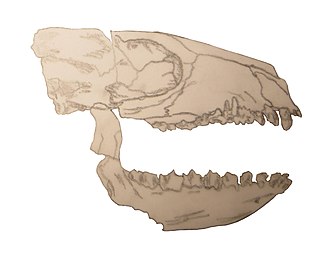Classification
Prtolitopterna ellipsodotoides was first described by Cifelli in 1983, based on fragmentary mandible preserving teeth, found in the Itaboraí Formation of Brazil, in terrains dated from the end of the Paleocene or the Early Eocene. Several other fossils were later found, making it possible to reconstruct its appearance and affinities.
Protolipterna was a basal litoptern, a clade of mammals that diversified in South America during the Cenozoic. Protolipterna is the eponymous genus of Protolipternidae, a possibly paraphyletic family including some of the most basal members of Litopterna. The name Protolipterna is an anagram of Litopterna coupled with the prefix proto-, "first". One of the close relatives of this genus was Asmithwoodwardia .

Pyrotheria is an order of extinct meridiungulate mammals. These elephant-like ungulates include the genera Baguatherium, Carolozittelia, Colombitherium, Griphodon, Propyrotherium, Proticia, and Pyrotherium.

Xenungulata is an order of extinct and primitive South American hoofed mammals that lived from the Late Paleocene to Early Eocene. Fossils of the order are known from deposits in Brazil, Argentina, Peru, and Colombia. The best known member of this enigmatic order is the genus Carodnia, a tapir-like and -sized animal with a gait similar to living African elephants.
Victorlemoinea is an extinct litoptern genus of the family Sparnotheriodontidae, that lived from the Early to Middle Eocene. Fossils of Victorlemoinea have been found in the Las Flores, Sarmiento and Koluel Kaike Formations of Argentina, the Itaboraí Formation of Brazil and La Meseta Formation, Antarctica.

Carodnia is an extinct genus of South American ungulate known from the Early Eocene of Brazil, Argentina, and Peru. Carodnia is placed in the order Xenungulata together with Etayoa and Notoetayoa.
Megadolodus is an extinct genus of proterotheriid litopterns.
Ernestokokenia is an extinct genus of mammal, belonging to the Didolodontidae. It lived during the Early Eocene and the Middle Eocene, and its fossils were discovered in South America.
Lamegoia is an extinct genus of mammals, belonging to the family Didolodontidae. It contains a single species, Lamegoia conodonta, which lived during the Late Paleocene in what is now South America.
Saltaodus is an extinct genus of mammals, belonging to the family Didolodontidae. It lived during the Late Eocene, in what is now South America.
Paulogervaisia is an extinct genus of mammal, belonging to the family Didolodontidae. Its fossilized remains have been found in South America.
Tetragonostylops is an extinct genus of mammal, related to Astrapotheria. It lived during the Late Paleocene, and its fossils were discovered in South America.
Asmithwoodwardia is an extinct genus of mammals, from the order Litopterna. It lived during the Late Paleocene and the Early Eocene, and its fossilized remains were found in South America.
Polymorphis is an extinct genus of litopterns belonging to the family Macraucheniidae. It lived during the Middle Eocene of Argentina.
Proadiantus(Ameghino, 1897) is an extinct genus of adianthid litoptern. It lived during the Late Oligocene, in what is today South America. It consists of only 1 species, Proadiantus excavatus.

Adiantoides is an extinct genus of herbivorous mammal, belonging to the order Litopterna. It lived during the Middle to Late Eocene, in South America.

Anisolambda is an extinct genus of litoptern. It lived from the Late Paleocene to the Middle Eocene in what is now Argentina.
Proectocion is an extinct genus of adianthid litoptern. It lived during the Early Eocene, in what is now South America.
Henricosbornia is an extinct genus of henricosborniid notoungulate that lived from the Late Paleocene to the Middle Eocene of what is now Argentina and Brazil.

Periphragnis is an extinct genus of isotemnid notoungulates that lived from the Middle Eocene to the Early Oligocene in what is now Argentina and Chile.
Oldfieldthomasia is an extinct genus of Notoungulate, probably related to the suborder Typotheria. It lived during the Middle Eocene, in what is today South America.
Paranisolambda is an extinct genus of proterotheriid litopterns from the Early to Middle Eocene of Brazil. Fossils of Paranisolambda have been recovered from the Itaboraí Formation in the Brazilian state of Rio de Janeiro.
This page is based on this
Wikipedia article Text is available under the
CC BY-SA 4.0 license; additional terms may apply.
Images, videos and audio are available under their respective licenses.













